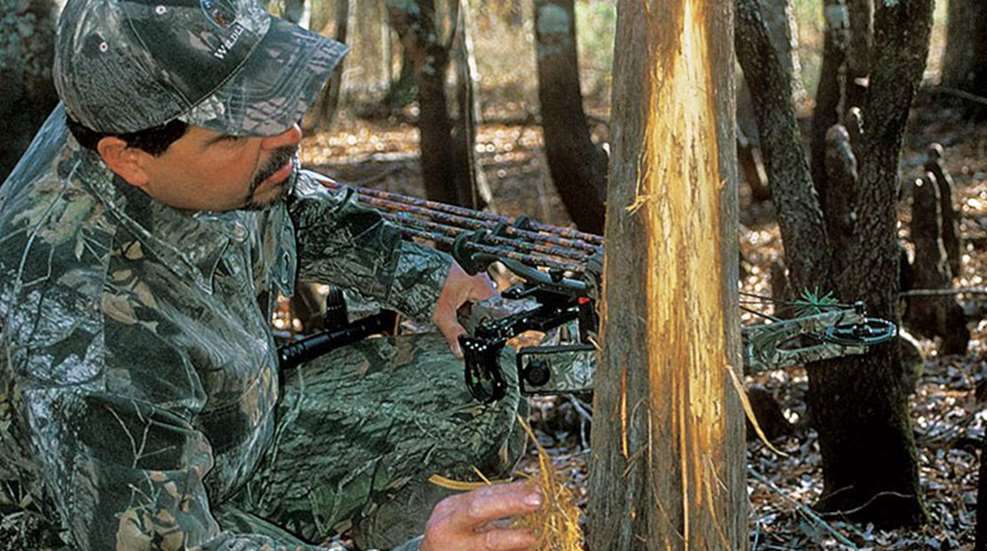
Use this photo tutorial to decipher the buck rubs you come across this fall. Sometimes reading sign such as rubs can help to pin down the movements of big deer.

Type: Ordinary
Tree: Pine or cedar 2 to 3 inches in diameter
What It Tells You: If you find 500 rubs, 400 will look sort of like this one. Studies show that in many areas, bucks blaze ordinary-looking rubs on aromatic cedar or pine trees 70 percent of the time. They make such rubs from velvet-shedding time in early September on through the rut. Six- or 8-pointers or a giant 10 might make them. You just never know.
Hunt Value: I’d say low to moderate. A lot of these rubs tell you multiple bucks are working your area; at least one ought to have a decent rack.
Tactic: Scout close to see if the rubs show a pattern. For example, if 70 percent of them are blazed on the upper sides of ridges, you can surmise that bucks side-hill most days, rather than walk on hilltops or in bottoms. Hang stands accordingly.

Type: Violent
Tree: Sapling or bush
What It Tells You: This dry, brown thrashing is weeks old and was likely made by a buck as he rid his rack of velvet and polished it. Look for a second volley of thrashed and/or snapped saplings or bushes (some yanked out of the ground) from around Halloween until November 15, as breeder bucks prowl and vent pent-up sexual energy until the first does pop into heat.
Hunt value: I’d say its value is moderate to high.
Tactic: September thrashings don’t mean squat. But definitely hunt on a ridge or in a creek bottom that has lots of fresh, ripped rubs the first weeks of November. The hot and bothered dude (actually, probably two or three of them) that is prowling through and trashing the joint is apt to slip up in daylight hours. Be there and shoot straight.

Type: Rut rub
Tree: Hardwood or pine 5 to 6 inches in diameter
What It Tells You: My buddy found this blazed cypress in an Alabama swamp on January 20 a few years ago (peak of the rut down there). Check out the shavings; they’re fresh! Look for solid rubs like that to start popping up in your woods two to three weeks before peak rut (starting around Halloween in most places). They are sign that an old deer has come from miles away to sniff out more does. As a rule, only mature breeders blaze these.
Hunt value: Rubs like these are a very good sign that a good buck is around.
Tactic: The more of these rubs that pop up on your land the better. Strike quick. Look for the thickest, most secluded cover in the area. You’ll probably find more fresh rubs there, because that is where Mr. Big travels a lot. Set a stand or blind where the wind is right and hunt a week solid in the late pre-rut. The bruiser won’t be on your land every day, but he’ll likely circle through three or four times. You might get him.

Type: Signpost
Tree: Cedar, pine tree or fence post 5 to 8 inches in diameter
What it tells you: This cedar post is the coolest rub I’ve ever found and the best illustration of a signpost you’ll ever see. Mature bucks blaze them in high-activity spots where other deer can easily see them. The aromatic post is in an enormous Montana wheat field. Different bucks work the rub year after year. The post was set back in the 1940s, and bucks have smoothed it into an hourglass ever since. Many signposts become community scent-wicks; bucks and does veer over to smell them and rub on pre-orbital/forehead scent. Note 1: No old deer would be caught rubbing the cedar post out in the open in daylight, so I surmise bucks have worked it at night for 60-plus years during the mid-November rut. Note 2: After we snapped this photo, a buddy and I lashed a rope to the post and pulled it out of the ground with his pickup. I figured it wouldn’t last much longer—a rut-crazed buck would probably snap the hourglass in half this fall. I kept it for a souvenir.
Hunt value: This is a good sign big bucks are around, but it can’t be hunted.
Tactic: I have never set a stand over a signpost rub, but I’ve hung plenty on ridges and in bottoms near the big rubs. A lot of bucks will cruise through a sign-posted area, though their patterns will be unpredictable. However, if you hunt there long enough you’ll shoot one.




































